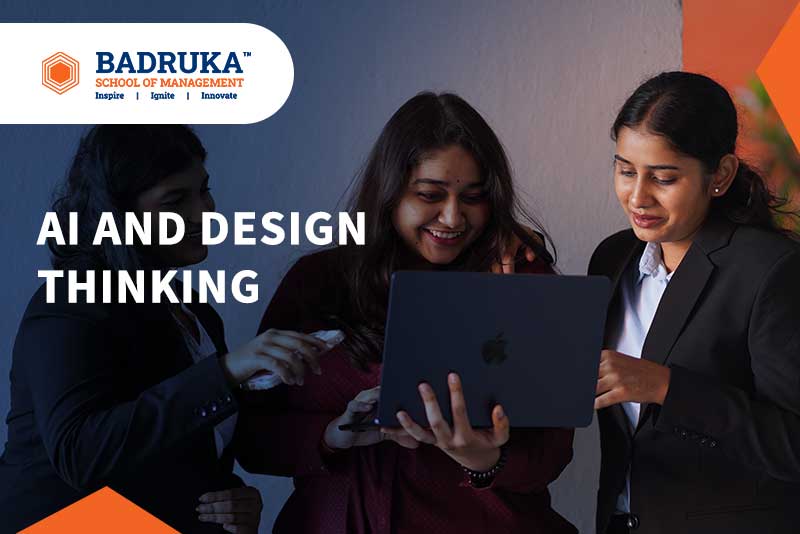Innovation powers success in today’s fast-paced and competitive business environment. Companies face challenges adapting to market dynamics, constantly changing consumer behaviours, and evolving technological advances. Transformative tools such as Artificial Intelligence (AI) and Design Thinking offer phenomenal ways to drive innovation. When combined,, leaders use these tools to solve business problems creatively and deliver user-centric solutions efficiently.
AI excels at analysing data, automating repetitive tasks, and predicting outcomes. It enhances the speed and depth of the innovation process. On the other hand, Design Thinking focuses on empathy, creativity, and iterative problem-solving. Together, AI and Design Thinking empower businesses to create meaningful solutions that deeply resonate with users. This article explains how integrating AI with Design Thinking redefines innovation, detailing its potential, benefits, and practical applications.
Example: Nike

Data x Empathy
Nike has nailed the collaboration between AI and Design Thinking by using AI to analyse customer data – from purchase history to social media interactions to predicting trends like what types of sneakers are gaining popularity in specific regions.
But here’s the kicker – they don’t stop at the data-they infuse empathy into every aspect of their customer experience. Empathy, in this context, is about understanding their customers’ emotions, motivations, and needs beyond what the numbers reveal. Nike did this by allowing customers to customise their sneakers. The data helped them tap into the emotional need for individuality, redesigned store layouts to make them intuitive and enjoyable, reducing decision fatigue and enhancing the overall experience by asking the right questions such as “How can we make this easier or more exciting for you?” – this level of empathy allowed them to design digital tools that integrated with physical stores seamlessly, creating a unified shopping experience. Nike also created impactful campaigns and initiatives that resonated with their target audience emotionally, like encouraging fitness for mental health or highlighting sustainability. They built trust by showing they care about the bigger picture-not just selling products.
By combining data with empathy, Nike doesn’t just sell shoes-they create experiences that customers love.
How does AI redefine creativity in Design Thinking?
AI is transforming the creative landscape by enabling teams to push boundaries and rethink traditional approaches. By analysing vast amounts of data and generating ideas that challenge conventional thinking, AI acts as a catalyst for innovation.
Picture a brainstorming session where human designers collaborate with AI tools to explore concepts that might have seemed impossible. AI enhances creativity by removing biases, suggesting novel solutions, and inspiring new directions. With tools like generative design algorithms, designers can produce multiple variations of a concept in minutes, encouraging experimentation and rapid iteration.
This partnership between human intuition and AI power unlocks a new level of creativity. Designers no longer have to start from scratch. Instead, they can refine AI-generated ideas to create solutions that balance innovation with functionality. This blend ensures that creativity remains at the heart of the process while AI provides the tools to accelerate and enhance it.
How does AI enhance Design Thinking?
Design Thinking takes a human-centred approach by understanding people’s needs and challenges. AI complements this approach by:
- Empathy and Research: AI tools like Natural Language Processing (NLP) analyse surveys, reviews, and social media. They identify patterns, sentiments, and opportunities that improve understanding of user needs.
- Problem Definition: AI visualises complex data, simplifying and identifying core problems. Predictive analytics highlight trends and potential challenges, guiding teams toward actionable solutions.
- Ideation: AI-powered tools generate innovative ideas by analysing historical data and trends. These tools inspire teams to explore diverse creative possibilities.
- Prototyping: Generative design algorithms produce multiple prototypes quickly based on specific criteria. Tools like Crazy Egg and Google Optimize facilitate testing and refinement.
- Testing and Iteration: AI simulates user interactions, providing real-time feedback. Tools like AB Tasty analyse behaviours, enabling immediate improvements.
Case Study: General Electric (GE)

General Electric (GE), one of the world’s largest industrial conglomerates, faced a major roadblock in product development. Despite significant investment in technology, its offerings often missed the mark with customers, leading to stagnation and reduced market relevance.
GE addressed this gap by integrating Design Thinking with AI. This is how the transformation unfolded:
- Approach: GE used Design Thinking to understand customer pain points while relying on AI to extract actionable insights from maintenance logs and feedback data.
- Execution: General Electric (GE) transformed its product development process by :
- Identifying the gaps with AI – GE started by feeding vast amounts of data into AI systems, including maintenance logs, operational data, and customer feedback. The AI tools identified recurring pain points, such as frequent breakdowns in particular machines or user frustration with unintuitive product features.
- Empathy-driven insights – Design Thinking played a crucial role here. Instead of stopping at the raw data, GE’s teams worked to understand why these pain points existed. They interviewed customers, conducted field observations, and mapped user journeys to understand better the emotional and functional challenges users faced.
- Redesigning interfaces with user needs in mind – Once the issues were apparent, GE’s designers and engineers collaborated to redesign product interfaces. AI simulated how users interacted with these interfaces, helping the team refine them in real-time. For example, machine control panels were redesigned to reduce complexity, making them more intuitive for operators.
- Iterative prototyping and testing with AI – Instead of traditional trial-and-error methods, GE used AI-driven simulations to test new designs virtually. AI predicted the potential outcomes of these prototypes, highlighting areas for improvement before physical testing. This saved time, reduced costs, and ensured every iteration moved closer to customers’ needs.
- Predictive maintenance solutions – GE integrated predictive maintenance into its products, allowing machines to detect and address issues before they become significant problems. AI continuously monitored performance and flagged early warning signs, while Design Thinking ensured these alerts were user-friendly and actionable.
- Collaborative feedback loops – AI and Design Thinking created a feedback loop throughout the process. AI insights informed the next steps in the design process, while customer feedback on prototypes helped refine AI models, ensuring that the technology adapted to real-world needs.
- Outcome: This synergy resulted in a 15% reduction in equipment downtime, higher customer satisfaction due to tailored solutions, and increased market competitiveness through innovation.
What are the benefits of integrating AI & Design Thinking?
Combining AI with Design Thinking offers significant advantages:
- Enhanced Creativity: AI generates unconventional ideas, breaking cognitive biases and expanding creative horizons.
- Improved Efficiency: Automation reduces repetitive tasks, allowing teams to focus on strategic decisions and innovation.
- Deeper User Insights: AI analyses vast datasets to uncover user behaviours and preferences, enabling informed decision-making.
- Greater Accuracy: AI-driven tools simulate diverse user scenarios and provide real-time feedback, ensuring effective solutions.
These benefits streamline processes and ensure that final solutions are innovative and user-focused. Companies like Burberry have successfully demonstrated how AI-driven Design Thinking transforms industries.
What are the challenges to consider when using AI in Design Thinking?
Despite its potential, integrating AI into Design Thinking presents challenges:
- Balancing Human Intuition with AI: While AI provides insights, empathy and creativity remain human strengths. Achieving this balance is crucial.
- Data Privacy: Ethical data collection and analysis require transparency and strong security measures to protect user information.
- Resistance to Change: Teams may hesitate to adopt new technologies. Clear communication, gradual implementation, and training can ease this transition.
- Maintaining Human-Centred Design: Even with AI automation, the focus must remain on understanding and addressing user needs.
So, what’s the fix? Upskill yourself or your team. Many top B-schools now offer industry-relevant PGDM programmes that teach how to blend AI and Design Thinking like a pro.
Wrapping it up!
AI and Design Thinking together represent a powerful approach to innovation. Combining AI’s analytical strength with human creativity allows businesses to solve problems effectively and deliver meaningful solutions. This collaboration accelerates problem-solving, deepens user insights, and improves efficiency. Leaders and teams ready to navigate the complexities of the modern world should embrace this transformative combination to stay ahead in a competitive landscape. For anyone dreaming of leading this revolution, there’s no better time to prep. PGDM programs that blend AI and Design Thinking are the ultimate playground for future innovators.




